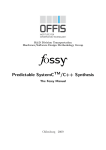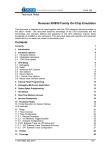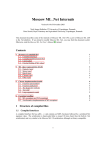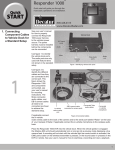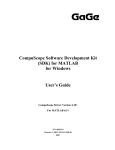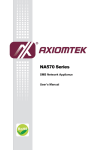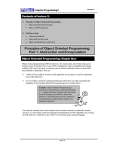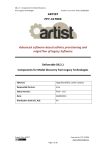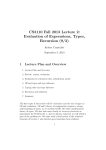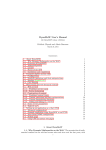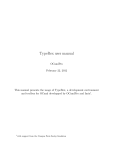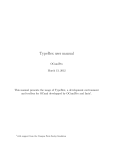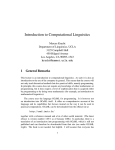Download csml: high-level bindings between C# and OCaml
Transcript
csml: high-level bindings between C# and
OCaml
Alain Frisch
LexiFi SAS
August 2008
2
Contents
1 Foreword
1.1 License and availability . . . . . . . . . . . . . . . . . . . . . . .
1.2 Requirements . . . . . . . . . . . . . . . . . . . . . . . . . . . . .
5
5
5
2 Design principles and goals
7
3 csml scripts
3.1 Overview of the system . . . . . . . . . . . .
3.2 Basic types . . . . . . . . . . . . . . . . . . .
3.2.1 Integers . . . . . . . . . . . . . . . . .
3.2.2 Strings . . . . . . . . . . . . . . . . . .
3.2.3 Blobs . . . . . . . . . . . . . . . . . .
3.2.4 void/unit . . . . . . . . . . . . . . .
3.3 Structural types . . . . . . . . . . . . . . . .
3.3.1 List and arrays . . . . . . . . . . . . .
3.3.2 Options, nullable types . . . . . . . .
3.3.3 Tuples . . . . . . . . . . . . . . . . . .
3.3.4 Functions . . . . . . . . . . . . . . . .
3.4 Organizing the imported components . . . . .
3.4.1 Choosing file names . . . . . . . . . .
3.4.2 Namespaces and classes in C# . . . .
3.4.3 Modules in OCaml . . . . . . . . . . .
3.4.4 Inline code . . . . . . . . . . . . . . .
3.5 Exceptions . . . . . . . . . . . . . . . . . . .
3.6 Exporting OCaml values opaquely . . . . . .
3.6.1 Running example . . . . . . . . . . . .
3.6.2 Extending the class with custom code
3.6.3 About garbage collection . . . . . . .
3.7 Exporting C# values opaquely . . . . . . . .
3.7.1 Running example . . . . . . . . . . . .
3.7.2 Special methods . . . . . . . . . . . .
3.7.3 Indexed accesors . . . . . . . . . . . .
3.7.4 Accessing sub-components . . . . . . .
3.7.5 Ignoring the result . . . . . . . . . . .
3
.
.
.
.
.
.
.
.
.
.
.
.
.
.
.
.
.
.
.
.
.
.
.
.
.
.
.
.
.
.
.
.
.
.
.
.
.
.
.
.
.
.
.
.
.
.
.
.
.
.
.
.
.
.
.
.
.
.
.
.
.
.
.
.
.
.
.
.
.
.
.
.
.
.
.
.
.
.
.
.
.
.
.
.
.
.
.
.
.
.
.
.
.
.
.
.
.
.
.
.
.
.
.
.
.
.
.
.
.
.
.
.
.
.
.
.
.
.
.
.
.
.
.
.
.
.
.
.
.
.
.
.
.
.
.
.
.
.
.
.
.
.
.
.
.
.
.
.
.
.
.
.
.
.
.
.
.
.
.
.
.
.
.
.
.
.
.
.
.
.
.
.
.
.
.
.
.
.
.
.
.
.
.
.
.
.
.
.
.
.
.
.
.
.
.
.
.
.
.
.
.
.
.
.
.
.
.
.
.
.
.
.
.
.
.
.
.
.
.
.
.
.
.
.
.
.
.
.
.
.
.
.
.
.
.
.
.
.
.
.
.
.
.
.
.
.
.
.
.
.
.
.
.
.
.
.
.
.
.
.
.
.
.
.
.
.
.
.
.
.
.
.
.
.
.
.
.
.
.
.
.
.
.
.
.
.
.
.
.
.
.
.
.
.
.
.
.
9
9
10
10
11
11
11
11
11
12
12
13
14
14
15
16
16
17
18
18
20
20
21
21
22
23
23
24
4
CONTENTS
3.7.6 Weak references . . . . . . . . . . . . . . . . . . . . . . .
Binding C# classes to OCaml classes . . . . . . . . . . . . . . . .
3.8.1 Inheritance . . . . . . . . . . . . . . . . . . . . . . . . . .
3.9 Structurally reflecting OCaml datastructures into C# classes . .
3.9.1 Records . . . . . . . . . . . . . . . . . . . . . . . . . . . .
3.9.2 Variants . . . . . . . . . . . . . . . . . . . . . . . . . . . .
3.10 Mapping C# enumerations into OCaml variants of polymorphic
variants . . . . . . . . . . . . . . . . . . . . . . . . . . . . . . . .
3.11 Resolution of recursive types . . . . . . . . . . . . . . . . . . . .
3.12 Dependent csml scripts . . . . . . . . . . . . . . . . . . . . . . .
3.8
4 Using csml
4.1 Using the compiler . . . . . . . . . . . .
4.2 Computing dependencies . . . . . . . . .
4.3 Linking . . . . . . . . . . . . . . . . . .
4.3.1 Initialization . . . . . . . . . . .
4.3.2 Static linking . . . . . . . . . . .
4.3.3 Dynamic linking . . . . . . . . .
4.3.4 Linking the OCaml code without
4.4 A note on initialization order . . . . . .
4.5 A note on environment variables . . . .
5 Formal syntax
. .
. .
. .
. .
. .
. .
the
. .
. .
. . . . . .
. . . . . .
. . . . . .
. . . . . .
. . . . . .
. . . . . .
C# part
. . . . . .
. . . . . .
.
.
.
.
.
.
.
.
.
.
.
.
.
.
.
.
.
.
.
.
.
.
.
.
.
.
.
.
.
.
.
.
.
.
.
.
.
.
.
.
.
.
.
.
.
.
.
.
.
.
.
.
.
.
24
24
25
26
26
28
30
31
33
35
35
35
35
36
36
36
37
37
37
39
Chapter 1
Foreword
This manual documents the csml system. It is organized as follows.
• Chapter 2 explains some design principles and goals of CSML.
• Chapter 3 gives an overview of the system and of CSML scripts.
• Chapter 4 explains how to use CSML in practice.
• Chapter 5 gives the formal syntax of CSML scripts.
1.1
License and availability
The home page for csml system is http://www.lexifi.com/csml.
The csml compiler is distributed free of charge, but only in binary form.
The csml runtime support is made of C, OCaml and C# units. It is distributed
in source form under the terms of an open-source license (LGPL + the typical
linking exception for OCaml libraries). The details of the licenses for the csml
compiler and the csml runtime support are included in the LICENSE file of
the distribution.
LexiFi SAS is willing to cooperate with other people interested in improving
the CSML system. Feel free to apply for a source distribution of the compiler.
1.2
Requirements
See the README file in the distribution.
5
6
CHAPTER 1. FOREWORD
Chapter 2
Design principles and goals
csml is a system to help developing applications that freely mix OCaml and
C# code.
csml has been developed by LexiFi SAS as an internal development tool.
LexiFi has decided to distribute it to help people write their Windows applications with OCaml. LexiFi uses csml for the following scenarios:
• Wrapping .Net libraries (like Winforms) to make them available to OCaml
applications.
• Providing a .Net API to OCaml applications.
• Developping mixed applications, where some parts are implemented in
OCaml and other parts in C#.
Technically, both OCaml and C# provide relatively low-level interfaces to
C. csml relies on these internally but it exposes much higher-level concepts. In
particular, some care has been taken to ensure the following properties.
High-level binding csml hides to the user the complexity of low-level bindings such as memory management, in-memory layout of objects, translation of
complex values.
User-control The user is in charge of organizing the binding code as he sees
fit. Basically, one describes the interface that one expects to get in one language
when importing components from the other language. In particular, it is possible
to choose custom names for imported components and to organize them into
classes or namespaces in C#, and classes or modules in OCaml.
Type-safety The interface does not compromise static type-safety as provided
by each language. Type information from each language is reflected in the other
and is checked at compile-time.
7
8
CHAPTER 2. DESIGN PRINCIPLES AND GOALS
Opaque or structural translation of values The system supports passing
value abstractly from one language to the other (which means that it is seen as an
opaque value there); it also supports translating datastructures in a structural
way (basic types, sum types, record types, lists, arrays, options, . . . ).
GC-safety The user of csml does not need to worry about making the two
garbage collectors live together. csml takes care of registering and releasing
GC pointers from one heap to the other one. That said, the system also offers
some fine-tuning features to optimize performance and deal with tricky cases
like circular references between the two heaps.
Support for exceptions Exceptions raised in one language are wrapped in
the other language as regular exceptions, and round-tripping is supported (e.g.
a C# exception that escapes to OCaml and then back to C# will retain all the
information from the original one).
Support for first-class functions First-class functions (in OCaml) and delegates (in C#) are considered seriously in csml. The system relies on predefined
C# generic delegates to mimic the structural aspect of OCaml arrow types. A
C# delegate is wrapped into an OCaml closure when it enters to OCaml world.
Similarly, an OCaml closure is wrapped into a C# delegate when it goes to
the C# world; if this delegate is later sent back to OCaml, it is unwrapped to
retrieve the original closure instead of being wrapped again.
Chapter 3
csml scripts
3.1
Overview of the system
The csml system is made of a compiler and a runtime support library. The
compiler takes a csml script which describes C# and OCaml components to be
exported from their native language to the other one, and produces a number
of OCaml and C# source files. Those files have to be compiled and linked with
the rest of the application and the csml runtime support library.
The csml scripts usually have the extension .csml. They describe how
imported components should look like in their target language. For instance,
here is one section of such a script:
mlfile "getting_started_cs.ml"
module FooBar: sig
val bipbip: int -> int -> unit = static Getting.Started.Foo.BipBip
end
This section tells the compiler to produce an OCaml file getting_started_cs.ml
that imports the static method Getting.Started.Foo.BipBip defined in C#.
This method should be wrapped as an OCaml function called bipbip located
in a submodule FooBar of the OCaml compilation unit Getting_started_cs.
To be compatible with the code above, the C# method must have the following
signature:
public static void BipBip(int, int);
If the signature of the method is different, there is a type-error when the
C# files generated by the script are compiled.
Let us look at an example of how to import functions from OCaml to C#.
9
10
CHAPTER 3. CSML SCRIPTS
csfile "getting_started_csml.cs"
namespace Getting.Started {
public static class Foo {
public static class MyStaticClass {
public static string DoSomething(string) = Getting_started.do_something;
}
}
}
This section tells the compiler to produce a C# file getting_started_csml.cs
which defines a static class Foo in the namespace Getting.Started, with a
static inner-class MyStaticClass that contains a single static method DoSomething.
This method is imported from the OCaml function Getting_started.do_something,
which must have type string -> string.
Here are some more examples of OCaml signatures together with their C#
equivalent (for csml):
OCaml
unit -> unit
int -> unit
unit -> int
int -> int -> unit
int -> int -> int
3.2
C#
void F();
void F(int);
int F();
void F(int, int);
int F(int, int);
Basic types
For most basic types, there is a natural correspondence between C# and OCaml.
C#
void
int
long
double
string
bool
Exception
3.2.1
OCaml
unit
int
int64
float
string
bool
exn
Integers
The OCaml type int stores 31-bit integers (on 32-bits machines). When a C#
integer that does fit within 31-bit is translated to OCaml, the behavior is not
specified.
3.3. STRUCTURAL TYPES
3.2.2
11
Strings
C# strings represent sequences of Unicode characters. When copied to and from
C#, OCaml strings are interpreted as sequences of characters in the Latin1 (iso9959-1) subset of Unicode. If a C# string that contains code points >= 256 is
copied to OCaml, the result is undefined. An OCaml string copied to C# and
then back to OCaml is guaranteed to be equal to the original string.
3.2.3
Blobs
OCaml strings are often used as sequences of bytes. To support this common
case, csml understands a special type, written byte[] in C# signatures and
blob in OCaml signatures. This type is mapped to the OCaml type string
and to the C# type byte[].
For instance, the following specification assumes that the imported OCaml
function has type string -> string:
public static string f(byte[]) = M.f;
and the following specification assumes that the imported C# method has
signature byte[] F(byte[]).
val f: blob -> blob = static C.F
3.2.4
void/unit
The C# void “type” can only appear as the result type of a method. It corresponds to the result type unit in OCaml. A C# method that takes an empty
list of arguments corresponds to an OCaml function that takes a single argument of type unit. The type unit can only appear as the single argument of a
function and/or as the result of a function.
3.3
Structural types
Structural types (lists, arrays, options, tuples) are very common in OCaml
signatures.
3.3.1
List and arrays
List and arrays have a natural correspondence in C#.
C#
T[]
List<T>
OCaml
’a array
’a list
The C# generic class List is defined in the namespace System.Collections.Generic
(but one simply write List in csml scripts). The following line is an example of
how to import in OCaml a C# static method of signature List<string[]> F(List<int>).
12
CHAPTER 3. CSML SCRIPTS
val f: int list -> string array list = static C.F
3.3.2
Options, nullable types
In OCaml, the built-in parameterized type option is defined as:
type ’a option = Some of ’a | None
csml’s standard library defines a C# generic class Lexifi.Interop.Option<T>
to reflect this type. Here is the current signature for this class:
public class OptionNoneException : Lexifi.LexiFi_exception {
public OptionNoneException(Type T);
}
public class Option<T> {
public Option(T x); // Create a Some option
public Option();
// Create a None option
public bool Is_some{ get; } // Check whether the option is Some
public void Clear(); // Set the option to None
public T Val { get; set; } // Get or set the value
}
The getter of the property Val throw an exception Lexifi.Interop.OptionNoneException
if the current value of the option is None.
In some cases, we do not want to reflect an OCaml option type explicitly in
C#. Instead, we might like to use the C# null value to represent None. The
csml compiler understands a pseudo-type written α nullable in OCaml parts
and Nullable<T> in C# parts. This type really means α option in OCaml
and just T in C#: Some values are mapped to and from values of type T and
None is mapped to and from null. Here is an example that shows how to use
this feature to import a function from C# to OCaml:
val f: unit -> string nullable = static Myclass.f
The resulting OCaml function f has type unit -> string option, but the
static method Myclass.f returns a string, not a Option<string> as would be
the case if option had been used instead of nullable.
3.3.3
Tuples
C#
Tuple<T1,...Tn>
OCaml
’a1 * ...
* ’an
To reflect OCaml tuple types, csml’s standard library defines C# generic
classes Lexifi.Interop.Tuple<T0,T1>, Lexifi.Interop.Tuple<T0,T1,T2>, . . . ,
Lexifi.Interop.Tuple<T0,T1,...,T10>. Here is the current signature for one
of them:
3.3. STRUCTURAL TYPES
13
public class Tuple<T0, T1, T2, T3> {
public Tuple(T0 arg0, T1 arg1, T2 arg2, T3 arg3);
public T0 TVal0 { get; set }
public T1 TVal1 { get; set }
public T2 TVal2 { get; set }
public T3 TVal3 { get; set }
}
Let us look at the following example of a csml script fragment:
public static class C {
public static Tuple<Option<int>,string,int>
f(Option<Tuple<string,string>>) = M.f;
}
The imported OCaml function M.f must have type (string * string)
option -> (int option * string * int). Here is an example of how to call
the imported function:
Tuple<Option<int>,string,int> r =
C.f(new Option<Tuple<string,string>>(
new Tuple<string,string>("a", "b")));
if (r.TVal0.Is_some)
System.Console.WriteLine("I = " + r.TVal0.Val);
System.Console.WriteLine("S = " + r.TVal1);
3.3.4
Functions
C#
ArrowVoid
Arrow<S>
ArrowVoid<T1,...Tn>
Arrow<T1,...Tn,S>
OCaml
unit -> unit
unit -> ’a
’a1 -> ... -> ’an -> unit
’a1 -> ... -> ’an -> ’b
Function types and first-class functions are key features of the OCaml language. They are also available in C#. csml’s standard library defines families
of C# generic delegates as the counterpart of OCaml’s function types:
public
public
public
public
...
delegate
delegate
delegate
delegate
S
S
S
S
Arrow<S>();
Arrow<T0, S>(T0 arg0);
Arrow<T0, T1, S>(T0 arg0, T1 arg1);
Arrow<T0, T1, T2, S>(T0 arg0, T1 arg1, T2 arg2);
14
CHAPTER 3. CSML SCRIPTS
public
public
public
public
delegate
delegate
delegate
delegate
void
void
void
void
ArrowVoid();
ArrowVoid<T0>(T0 arg0);
ArrowVoid<T0, T1>(T0 arg0, T1 arg1);
ArrowVoid<T0, T1, T2>(T0 arg0, T1 arg1, T2 arg2);
The Ti correspond to the types of the arguments and S corresponds to the
type of the result.
For instance, the OCaml types int -> string -> string and int -> string -> unit
are mapped respectively to the C# types Arrow<int,string,string> and
ArrowVoid<int,string>.
Note that in OCaml, the two types int -> string -> string and int -> (string -> string)
are strictly equivalent. For csml, however, they are mapped to two different
types, namely Arrow<int,string,string> and Arrow<int,Arrow<string,string>>.
OCaml functional values are thus mapped to and from C# delegates. In
practice, a small wrapper is added to translate the arguments and result, and
to call the original function or delegate. When an OCaml function is translated
to a C# delegate and the same delegate is sent again to OCaml, the original
value is used (unwrapped), instead of a re-wrapped version of the delegate (as
would be the case for a delegate that did not originate from an OCaml function).
This avoids the problematic situation where a function which is sent back and
forth between the two languages would become fatter each time because of the
layers used while wrapping a function as a delegate or a delegate as a function.
3.4
Organizing the imported components
csml lets the programmer choose how the imported components should be
organized in the target language.
3.4.1
Choosing file names
A csml script is made of several sections. Each one describes the content of a
single source file (OCaml or C#) to be produced by the compiler. For instance,
the following script will produce three OCaml files and three C# files.
mlstub "ml_stub.ml"
csstub "cs_stub.cs" InitClass
mlfile "mymodule1.ml"
...
mlfile "mymodule2.ml"
...
csfile "myfile1.cs"
3.4. ORGANIZING THE IMPORTED COMPONENTS
15
...
csfile "myfile2.cs"
...
The directive mlstub lets us choose the name of a special OCaml source file
that contains all the code needed to export OCaml values to C#. This module
should be linked after all the OCaml modules that define values to be exported
to C#.
Similarly, the directive csstub allows us to choose the name of a special
C# source file that contains all the code to export C# components to OCaml
and all the glue code between C# and OCaml. The directive also takes a
second argument. It is the name of a class to be created in the namespace
LexiFi.Interop. This class has a static method void Init() that must be
called (it forces C# components to be actually exported to OCaml). In the
example above, the call should look like Lexifi.Interop.InitClass.Init();.
It is possible to reuse the same name as for the stub files in normal mlfile
or csfile sections; in that case, the stub code will simply be appended to the
corresponding file.
The decision to split the C# part of the script into several files makes it
possible to link the resulting files into different .Net assemblies.
This ability to produce several files is much more important for the OCaml
side. Indeed, the name of the .ml files constitutes the first layer in the module
hierarchy for fully qualified OCaml names. Also, because OCaml compilation
units cannot be mutually recursive, it is sometimes necessary to split the csml
script. For instance, one could imagine in the example above that mymodule1.ml
imports some components from C# that are used in a module foobar.ml (written by hand) and that mymodule2.ml refers to types defined in foobar.ml. In
such a case, the code for mymodule1.ml and mymodule2.ml cannot be merged.
3.4.2
Namespaces and classes in C#
The C# parts of csml scripts can be organized in several namespaces and
classes. Namespaces can be defined at the toplevel or within another namespace.
Classes can be defined at the toplevel or within another class or namespace. The
following modifiers are recognized for classes: public, private, static. The
classes generated by the csml compiler are always declared partial, which
makes it possible to extend them in hand-written C# source files (as long as
they are compiled and linked together with the files generated by the csml
compiler).
csfile "myfile1.cs"
namespace Foo {
namespace Bar {
16
CHAPTER 3. CSML SCRIPTS
public class A {
public static class B {
public static int F1(int) = M.f1;
}
}
public class C {
public static int X { get = M.f2; set = M.f3; }
}
}
}
In this example we import three functions from OCaml. The function M.f1
must have type int -> int; it is wrapped as a static method in the class
Foo.Bar.A.B. The function M.f2 is wrapped as the getter for the static property
Foo.Bar.C.X; it must have type unit -> int. Similarly, the function M.f3 is
wrapped as the setter for the same property. It is possible to define properties
with only a getter or a setter.
3.4.3
Modules in OCaml
The OCaml parts of csml scripts can be organized in (nested) modules.
mlfile "mymodule1.ml"
module M1: sig
module A: sig
val f: int -> int = static MyClass.F1
end
end
val f: int -> int -> unit = static MyClass.F2
val g: unit -> string = static get MyClass.G
val h: string -> unit = static set MyClass.G
In this example we import two static methods from the C# class MyClass
as two OCaml function Mymodule1.M1.A.f and Mymodule1.f. In addition, the
OCaml functions Mymodule1.g and Mymodule1.h import the getter and setter
for the static method MyClass.G.
It is also possible to use OCaml classes to organize code imported from C#.
We will see that later on.
3.4.4
Inline code
Sometimes it is convenient to insert small fragments of C# or OCaml code into
the code generated by csml. csml lets one use the following syntax in C# or
3.5. EXCEPTIONS
17
OCaml parts of csml scripts:
inline [* ... *]
For instance, the following csml script defines an additional OCaml function
defined in terms of those imported by csml:
mlfile "mymodule.ml"
module M: sig
val f_with_id: int -> string -> unit = static Foo.f
val f_without_id: string -> unit = static Foo.f
inline [*
let f ?id s =
match id with Some id -> f_with_id id s | None -> f_without_id s
*]
end
The same syntax can be used to insert comments used by tools that generate
documentation from source code:
csfile "myfile1.cs"
namespace Foo {
inline [*
/// <summary>
/// This is a very important class.
/// </summary>
*]
public class A {
}
}
3.5
Exceptions
Exceptions are properly supported by csml. An exception raised in one language is wrapped as an exception of the other language and it can be captured
there. If it goes back to its native language, then the original exception value
is extracted (as opposed to being wrapped again).
C#
System.Exception
OCaml
exn
18
CHAPTER 3. CSML SCRIPTS
The OCaml module Csml_iface, which is part of csml’s runtime library
defines an OCaml exception that wraps all the C# exceptions:
exception Csharp_exception of string * string * cshandle
The first argument is the C# exception’s type name. The second argument
is the exception’s message. The third one is an opaque pointer to the original
exception.
Similarly, the csml runtime library defines a C# exception class LexiFi.Interop.MLException
that encapsulates OCaml exceptions. The Message property of this exception class calls the OCaml function Csml_iface.print_exception (of type
exn -> string). It is possible to provide a custom implementation for this
function, using the Csml_iface.print_exception_ref reference. The default
implementation uses Printexc.to_string and can be extended by the OCaml
part of the application with custom printers for some exceptions (they can be
registered with Csml_iface.register_exception_print).
3.6
Exporting OCaml values opaquely
Up to this point, we have only seen how to import functions (from OCaml
to C#) and static method (from C# to OCaml) that operate on built-in types
(basic types or structural types). It is possible to extend to set of types that can
flow from one language to the other. In this section, we will see how to create
C# classes that wraps OCaml values in an opaque way. By opaque, we mean
that the values themselves always stay in their native heap (here the OCaml
heap); they are never copied. Instead, a pointer from the target language to the
native one is used and wrapped as a typed object.
3.6.1
Running example
Let us consider the following OCaml unit opaque_binding.ml.
type t = {
mutable foo: int;
mutable bar: int;
}
let
let
let
let
let
let
let
to_string c = Printf.sprintf "foo = %i, bar = %i" c.foo c.bar
get_foo c = c.foo
set_foo c x = c.foo <- x
get_bar c = c.bar
set_bar c x = c.bar <- x
create foo bar = { foo = foo; bar = bar }
version () = "1.0"
3.6. EXPORTING OCAML VALUES OPAQUELY
19
This module defines a type t that we would like to bind to a C# class. Since
values of type t encapsulate mutable states, it would be inappropriate to copy
their content to C#.
The following section is enough to let csml knows about the type t and
produces the needed machinery to map values of this type to and from instances
of a class Counter:
public class Counter = Opaque_binding.t {
}
With this declaration, it is now possible to import functions that operate on
type Opaque_binding.t as in:
public static class MyClass {
public static void SetFoo(Counter, int) = Opaque_bindng.set_foo;
}
The static method SetFoo wraps the function Opaque_binding.set_foo,
which must have type Opaque_binding.t -> int -> unit (because the OCaml
type Opaque_binding.tw is in correspondence with the C# class Counter).
It would make more sense to import functions directly related to the type
Opaque_binding.set_foo as components of the class Counter. Indeed, csml
lets us define constructors, instance methods and properties for C# class that
wraps OCaml types opaquely. Constructors can be defined from functions that
return values of the wrapped type. Instance methods reflect functions that take
the wrapped value as an implicit extra first argument. A property getter takes
the wrapped value as their only argument and return the value of the property.
A property setter takes two arguments: the wrapped value and the new value
for the property.
It is possibly to define overloaded constructors and methods following the
regular C# mechanism.
public class Counter = Opaque_binding.t {
public Counter(int, int) = Opaque_binding.create;
public Counter() = [* fun () -> Opaque_binding.create 0 0 *];
public static Counter Create(int, int) = Opaque_binding.create;
public int Linear(int) =
[* fun c i ->
c.Opaque_binding.foo + i * c.Opaque_binding.bar *];
public int Bar {
get = Opaque_binding.get_bar;
set = Opaque_binding.set_bar;
}
public int Foo {
20
CHAPTER 3. CSML SCRIPTS
get = [* fun c -> c.Opaque_binding.foo *];
set = [* fun c x -> c.Opaque_binding.foo <- x *];
}
public static string Version { get = Opaque_binding.version; }
public override string ToString() = Opaque_binding.to_string;
}
This is our first use of the [* ... *] notation. It is used here to put inline
OCaml definitions for C# components. All such pieces of OCaml code are put
in the OCaml stub file (see Section 3.4.1), so the code above works as long as
we do not add an explicit interface opaque_binding.mli to hide the concrete
definition of the type t.
The method ToString overrides the corresponding method from the parent
class Object.
3.6.2
Extending the class with custom code
It is not currently possible to specify in the csml script that a C# class inherits
from another class or implements a C# interface, but it is possible to add this
information in a hand-written C# file, using the fact that the classed generated
by the csml compiler are partial. Here is an example of such a hand-written
file to show how to express that Counter implements some interface:
public interface ICounter {
int Linear(int i);
}
public partial class Counter : ICounter {
}
Of course, it is also possible to add arbitrary extra components to the class
Counter.
3.6.3
About garbage collection
When an OCaml value must be mapped opaquely to C#, a global root is registered with the OCaml garbage collector and an handle to it is passed to C#.
This is to ensure that the OCaml value will not be discarded by the garbage
collector while the C# code still has a pointer to it. The global root is released
when the C# object that wraps this handle is released by the C# garbage
collector.
It is possible to release explicitly the global root hidden behind the C#
wrapper. To do this, one must declare a special method like that:
3.7. EXPORTING C# VALUES OPAQUELY
21
public class Counter = Opaque_binding.t {
...
public void KillMe() = kill;
...
}
The keyword kill is recognized by the csml compiler. When the method
KillMe is called, the underlying handle is released. Any further access will
result in an exception being raised.
3.7
Exporting C# values opaquely
In the previous section, we have seen how to wrap OCaml values as C# objects
in a opaque way. We can do the same the other way around, that is, we can bind
arbitrary C# types to custom abstract OCaml types. At runtime, C# values
are kept in the C# heap and the OCaml program only manipulates pointers to
C# values.
3.7.1
Running example
Let us consider the following C# class that we want to bind to OCaml.
public class MyClass {
private int i = 0;
public MyClass() { }
public MyClass(int i) { this.i = i; }
public int Value { get { return i; }
public void Bump() { i++; }
public void Bump(int x) { i += x; }
set { i = value; } }
private static MyClass glb = null;
public static Global { get { return glb; }
set { glb = value; } }
}
We can use the following csml script to bind this class to an abstract type
and import its components as OCaml functions.
type t = MyClass
val
val
val
val
val
create: unit -> t = ctor
create_init: int -> t = ctor
get: t -> int = get Value
set: t -> int -> unit = set Value
bump: t -> unit = instance Bump
22
CHAPTER 3. CSML SCRIPTS
val bump_n: t -> int -> unit = instance Bump
val global: unit -> t = static get MyClass.Global
As we can see, we describe on the right-hand side of each declaration (after the = sign) what C# component should be imported. We had seen previously how to import C# static method (static keyword) and static properties
(static get, static set). Here we see examples of how to import constructors (ctor keyword), getter and setters for instance properties (get, set) and
instance methods (instance). Note that for non-static components, the righthand sides do not mention the class to which the components belong. This class
is defined implicitly by the first argument (for properties and instance methods)
or by the result type (for constructors).
Note that the get and set keywords can be used to access not only public
properties, but also public fields.
3.7.2
Special methods
The csml compiler recognizes other possible keywords on the right-hand side of
declarations in OCaml parts. Here we consider three special pseudo-methods.
Checking for nullness The MyClass.Global property can return null. As
a consequence, the function global above might return something which is not
really an object. It is possible to define a function that checks whether a value
of type t is actually null or not:
val isitnull: t -> bool = isnull
Casting Imagine we have defined two abstract types t1 and t2 to wraps two
C# classes C1 and C2. We can define a function that cast objects of class C1 to
class C2:
val t2_of_t1: t1 -> t2 = cast
The C# code generated for this cast uses the C# as operator. As a consequence, this function can return null. If we want to get an option instead of a
possibly null value (which can be checked with an isnull function as above),
we can use the nullable pseudo-type (See Section 3.3.2):
val t2_of_t1: t1 -> t2 nullable = cast
3.7. EXPORTING C# VALUES OPAQUELY
23
Killing the pointer One can define a function that kills the reference to
the underlying C# object. If such a function is not called on a value that
wraps a C# object, one must wait for the OCaml value to be released by the
OCaml garbage collector before the reference is released (and the C# object
can potentially be released by the C# garbage collector). This is done by the
special keyword kill:
val killit: t1 -> unit = kill
3.7.3
Indexed accesors
It is possible to define OCaml functions to access indexed properties. For instance, if the C# class bound to the type t has a property p with an indexer
that maps strings to integers, it is possible to define OCaml function like that:
val get_p: t -> string -> int = indexed get p
val set_p: t -> string -> int -> unit = indexed set p
If the class bound to t itself has such an indexer, we can use this instead
of the property name:
val get_p: t -> string -> int = indexed get this
val set_p: t -> string -> int -> unit = indexed set this
There are also static variants for the indexed accessors. Imagine that the C#
expression Foo.Instance resolves to an object with a property p that defines
an accessor as above. We can define:
val get_p: string -> int = static indexed get Foo.Instance.p
val set_p: string -> int -> unit = static indexed set Foo.Instance.p
3.7.4
Accessing sub-components
It is possible to use the static, instance and other keywords to bind directly
sub-components as long as they are expressible as a qualified identifier (with
the dot notation). For instance, we could create OCaml functions that access
directly components of the Global property:
val bump_global: unit -> unit = static MyClass.Global.Bump
val get_global: unit -> int = static get MyClass.Global.Value
24
3.7.5
CHAPTER 3. CSML SCRIPTS
Ignoring the result
If we want to import a C# method as an OCaml function, we need to provide
the result type of the method, even if we do not care about the result. For
instance, if the method takes an integer and returns a string, we must write
something like:
val f: int -> string = static Foo.f
It it possible to ignore the result explicitly so that we can use unit as the
return type:
val f: int -> unit = ignore static Foo.f
3.7.6
Weak references
In many cases, it is not necessary to keep a strong reference to the C# object.
csml makes it possible to keep only a weak reference which does not prevent
the C# garbage collector from reclaiming the underlying C# object. This is
especially interesting if we have cycles between the two heaps (e.g. an OCaml
record that keep a pointer to a C# object, which itself keeps a pointer to the
OCaml record), because in that case, without weak references, we would need
to explicitly break cycles (e.g. using pseudo kill functions and methods).
We can annotate types of values that flow opaquely from C# to OCaml with
an annotation in order to produce weak references instead of strong ones. The
syntax is α weak in OCaml parts and Weak<T> in C# parts.
val global_weak: unit -> t weak = static get MyClass.Global
...
public class M {
public static void F(Weak<MyClass>) = Module.f;
}
3.8
Binding C# classes to OCaml classes
We have seen that arbitrary C# objects can be wrapped as opaque pointers in
OCaml. It is also possible to wrap them as OCaml objects.
We recall here an example seen above:
type t = MyClass
3.8. BINDING C# CLASSES TO OCAML CLASSES
val
val
val
val
val
val
val
25
create: unit -> t = ctor
create_init: int -> t = ctor
get: t -> int = get Value
set: t -> int -> unit = set Value
bump: t -> unit = instance Bump
bump_n: t -> int -> unit = instance Bump
global: unit -> t = static get MyClass.Global
We replace the first line with:
class t = MyClass : object
end
The effect of this declaration is that C# objects class MyClass will be reflected in OCaml as objects. The other definitions are still valid, but the ones
that take t as their first argument can be replaced by methods:
class t = MyClass : object
method get: int = get Value
method set: int -> unit = set Value
method bump: unit = instance Bump
method bump_n: int -> unit = instance Bump
end
val create: unit -> t = ctor
val create_init: int -> t = ctor
val global: unit -> t = static get MyClass.Global
Note that the OCaml constructor cannot be used to reflect the C# constructors. (It is used internally by csml.)
It is possible to define OCaml methods as importing static C# methods,
as long as these C# methods takes an object of the correct class as their first
argument.
In addition to the method described explicitly in the csml script, the generated class also contains some internal methods.
3.8.1
Inheritance
Imagine that C2 is a subclass of C1 in C#. It is possible to reflect this in the
imported classes:
class t1 = C1 : object
..
end
26
CHAPTER 3. CSML SCRIPTS
class t2 = C2 : object
inherit t1
...
end
The OCaml type t2 will then be a subtype of t1. Up-casting can thus be
implemented simply with the OCaml syntax (e :> t1).
For down-casting, we can use, as expected, the cast keyword. We can simply
define a function to do the cast:
val t2_from_t1: t1 -> t2 nullable = cast
Or we can add this as a method of t1:
class t1 = C1 : object
val to_t2: t2 nullable = cast
end
3.9
Structurally reflecting OCaml datastructures
into C# classes
We have seen how to manipulate opaque handle on arbitrary OCaml values
from C#. Sometimes, we would like to transform structured OCaml values into
native C# values. csml is able to produce C# class declarations to reflect
OCaml variant and record types, and to translate the OCaml value to and from
this C# representation.
3.9.1
Records
Imagine that we want to bind some record type defined in OCaml:
type myrecord = {
x: int;
y: myrecord option;
}
As we have seen before, it is possible to reflect this type opaquely to C#
with a csml script like:
public class MyRecord = Structured_mapping.myrecord
{
}
3.9. STRUCTURALLY REFLECTING OCAML DATASTRUCTURES INTO C# CLASSES27
If we want instead csml to copy the record fields into a real C# object, we
need to inform csml about the concrete definition of the type Structured_mapping.myrecord.
We do this by repeating the definition of the type (with fully explicit paths for
OCaml types):
public class MyRecord = Structured_mapping.myrecord =
{
x: int;
y: Structured_mapping.myrecord option;
}
{
}
From this script, csml produces a class declaration which implements the
following signature (plus some additional fields for its own internal use):
public partial class MyRecord {
public MyRecord(int, LexiFi.Interop.Option<MyRecord>);
public int x { get; set; }
public LexiFi.Interop.Option<MyRecord> y { get; set; }
...
}
Also, the types Structured_mapping.myrecord and MyRecord are now available in the rest of the csml script: values of those types are copied structurally
when crossing the boundary between the languages.
We can see that the class defines one constructor that takes one argument
for each field of the record, and one property (with a getter and a setter) for
each field.
Custom field names csml allows one to specify custom names for fields.
For instamce, if we want the OCaml field x to produce a property named to
First in C#, then we can write:
public class MyRecord = Structured_mapping.myrecord =
{
x as First: int;
y: Structured_mapping.myrecord option;
}
{
}
28
CHAPTER 3. CSML SCRIPTS
Private flag If the OCaml type were declared private, then we should add
the same flag to the csml script:
public class MyRecord = Structured_mapping.myrecord =
private
{
x: int;
y: Structured_mapping.myrecord option;
}
{
}
3.9.2
Variants
While OCaml record types have a natural translation into C#, this is less true
for variant types. csml suggests one possible encoding of variant types into
C#. Let us consider the following OCaml type declaration:
type myvariant =
| A
| B of string * int
| C of myvariant
As for records, the csml script to import this type to C# needs to repeat
the type definition:
public class MyVariant = Structured_mapping.myvariant =
| A
| B of string * int
| C of Structured_mapping.myvariant
{
}
The csml compilers produces an abstract class MyVariant:
public abstract partial class MyVariant {
public partial class A : MyVariant {
public A();
}
public partial class B : MyVariant {
public B(string, int)
public string TVal0 { get; set; }
public int TVal1 { get; set; }
3.9. STRUCTURALLY REFLECTING OCAML DATASTRUCTURES INTO C# CLASSES29
}
public partial class C : MyVariant {
public C(MyVariant)
private MyVariant val0;
public MyVariant TVal0 { get; set; }
}
public abstract class MatchVoid {
abstract public void A();
abstract public void B(string,int);
abstract public void C(MyVariant);
public void run(MyVariant x);
public static void RunMatch(MyVariant,
LexiFi.Interop.ArrowVoid,
LexiFi.Interop.ArrowVoid<string,int>,
LexiFi.Interop.ArrowVoid<MyVariant>);
}
public abstract class Match<T> {
abstract public T A();
abstract public T B(string,int);
abstract public T C(MyVariant);
public T run(MyVariant);
public static T RunMatch(MyVariant,
LexiFi.Interop.Arrow<T>,
LexiFi.Interop.Arrow<string,int,T>,
LexiFi.Interop.Arrow<MyVariant,T>);
}
There is one inner sub-class for each OCaml constructor of the variant type.
Each one looks a lot like the class generated for a record type, with one constructor and properties for the arguments.
Pattern matching The inner classes MatchVoid and Match<T> let us define
pattern matching on the type MyVariant (Match<T> is used when the pattern
matching returns a value). The methods RunMatch can be called directly; they
must be given the object of type MyVariant to be inspected and one delegate for
each possible case. The other possible way to implement pattern matching is to
sub-class MyVariant.MatchVoid or MyVariant.Match<T> (for some specific T).
The sub-class must implement one method for each OCaml constructor of the
variant type. This ensures that the matching is exhaustive. Here is an example
of such a pattern matching class:
public class VariantMatching : MyVariant.Match<int> {
override public int A() { return 1; }
override public int B(string s, int i) { return i; }
override public int C(MyVariant x) { return this.run(x); }
30
CHAPTER 3. CSML SCRIPTS
public static int Match(MyVariant x) {
return (new VariantMatching()).run(x);
}
}
Customizing the generated class There is one concrete sub-class on the
generated class for each case of the original OCaml type. By default, their
names correspond to the OCaml constructor, but it is possible to provide a
custom name. For instance, if we want to have a class MyVariant.Bee instead
of MyVariant.B, we can do:
public class MyVariant = Structured_mapping.myvariant =
| A
| B as Bee of string * int
| C of Structured_mapping.myvariant
{
}
It is also possible to give custom names for the arguments of each constructors, instead of the default TVal0, TVal1, . . . To do this, we use a record-like
notation:
public class MyVariant = Structured_mapping.myvariant =
| A
| B as Bee of { name: string; amount: int }
| C of Structured_mapping.myvariant
{
}
Private flag As for records, tf the OCaml type were declared private, then
we should add the same flag to the csml script.
3.10
Mapping C# enumerations into OCaml variants of polymorphic variants
The csml compiler supports binding C# enumerations to OCaml variants. This
feature is experimental and is likely to change. It is currently not documented.
TODO:...
3.11. RESOLUTION OF RECURSIVE TYPES
3.11
31
Resolution of recursive types
We have seen in the previous sections how to extend the set of admissible types
by specifying bindings between OCaml and C# types. As expected for C#
looking code, it is possible to refer in a C# section to any type defined anywhere
in the script. For instance, the following is legal:
csfile "myfile1.cs"
namespace X {
class A {
public static void f(B, C) = Foo.f;
// B refers to the one defined in myfile2.cs, which reflects an ML type
// C refers to the class C to be provided by an extra C# source file
//
of the project
}
}
csfile "myfile2.cs"
class B = Foo.t { }
mlfile "mymodule1.ml"
type s = C
// This informs csml about the C# type C
In this example, the module foo.ml must define a type t and a function f
of type t -> Mymodule1.s -> unit.
Maybe more suprisingly, the type definitions are also fully mutually recursive
for the OCaml sections. The following is thus valid:
mlfile "mymodule1.ml"
module A: sig
type t = Foo.A
val a_to_b: t -> B.t = cast
end
module B: sig
type t = Foo.B
val b_to_a: t -> A.t = cast
end
32
CHAPTER 3. CSML SCRIPTS
To support this kind of recursion, csml actually generates all OCaml type
declarations together (with mangled names) and then use those types. The code
above would produce a file mymodule1.ml that looks like:
type mymodule1_a_t
type mymodule1_b_t
module A = struct
type t = mymodule1_a_t
let a_to_b : mymodule1_a_t -> mymodule1_b_t = ...
end
module B = struct
type t = mymodule1_b_t
let b_to_a : mymodule1_b_t -> mymodule1_a_t = ...
end
To support recursion between several units, if the csml script has several
OCaml sections, then all the type declarations go at the beginning of the file
generated from the first one (which thus has a special role). In general this is ok.
But if this file comes with an explicit interface (.mli), then those mangled type
declarations might not be available where they needed. In that case, a solution
is to add an extra empty OCaml section at the beginning of the csml script to
act as a container for the type declaration. For instance, the following script
will force all the type declaration to go to a specific file mymodule_types.ml.
mlfile "mymodule_types.ml"
mlfile "mymodule1.ml"
module A: sig
type t = Foo.A
val a_to_b: t -> B.t = cast
end
module B: sig
type t = Foo.B
val b_to_a: t -> A.t = cast
end
3.12. DEPENDENT CSML SCRIPTS
3.12
33
Dependent csml scripts
It is of course possible to use several csml scripts for a single application. This
modularity is especially useful if we want to use csml to import library from
one language to the other.
As we have seen, in addition to specifying how to import components from
one language to the other (functions, methods), a csml script also defines a
correspondence between C# and OCaml types. In a csml script, it is possible
to refer to an external script with a use directive:
mlstub ...
csstub ...
use "external.csml"
Now, in the rest of this script, it is possible to use the type correspondence
as defined by external.csml (and the ones defined in scripts referred to from
this one, and so recursively). For instance, if external.csml defines that an
OCaml type A.t is an opaque counterpart for the C# type Foo.A, then we can
use those OCaml and C# types in the current script.
34
CHAPTER 3. CSML SCRIPTS
Chapter 4
Using csml
4.1
Using the compiler
The csml compiler is invoked with a simple command line like:
csml myscript.csml
where myscript.csml is a csml script. The compiler reads the script (and any
script referenced from it, see 3.12) and produces all the files according to the
mlstub, cstub, mlfile and csfile declarations.
It is important to note that the compiler does not access any other file. In
particular, it never parse OCaml.cmi files and it does not use .Net reflection
to check the type of the imported components. Instead, it produces OCaml
and C# source files that incorporate static type checking. If the C# or OCaml
compiler fail on one of these files, it means that the csml script contains an
invalid type for some of the imported component (usually, the message issued
by the compiler is clear enough to indicate the problem).
4.2
Computing dependencies
The following command line asks the csml compiler to produce on its standard
output a description of the dependencies implied by the csml script, in a format
suitable for inclusion in a Makefile:
csml -dep myscript.csml
4.3
Linking
A typical mixed C# and OCaml project is made of a number of C# and OCaml
units. Some of them are produced by the csml compiler and some of them are
35
36
CHAPTER 4. USING CSML
provided explicitly. There is some freedom in the way all these units are linked
together.
4.3.1
Initialization
The final application is always a .Net assembly that contains some C# parts of
the application (some of them can be linked in external DLLs). It must start
by calling all the initialization methods for the csml scripts that are part of the
application. For instance, if one of those script has a directive like:
csstub "cs_stub.cs" InitClass
then the main program must call Lexifi.Interop.InitClass.Init();.
4.3.2
Static linking
In this linking strategy, the OCaml part of the application is linked into a DLL
with the -output-obj option of ocamlc or ocamlopt. You must include two
libraries csml_standalone.cma and csml_init.cma into this DLL in addition
to all the libraries and user code needed by the application. Note that this
DLL contains not only the code for the application but also the OCaml runtime
system.
The C# part of the application is linked as a .Net assembly by the C# compiler. In addition to the code of application, you must link the C# file csml.cs
into this assembly. It is also necessary to link a small C# file that indicates the
name of the DLL produced above. The csml compiler can generates such a file:
csml -dllbind mydll.dll > mydll_ptr.cs
where mydll.dll is the name of the DLL with the OCaml application and
runtime system, and mydll_ptr.cs is the name of the C# file to be created.
This file must then be linked with csml.cs and the rest of the application.
4.3.3
Dynamic linking
The csml distribution comes with two pre-linked DLLs csml_ml_byt.dll and
csml_ml_opt.dll that contain the csml runtime library and the OCaml runtime (in bytecode or native form). These DLLs also contains the following
OCaml libraries: dynlink, bigarray, unix. The distribution also comes with
two files csml_ml_byt.cs and csml_ml_opt.cs that correspond of the output
of csml -dllbin applied to these DLLs.
To use these DLLs, one must link the application into one or several files that
can be linked (.cmo or .cma in bytecode, .cmxs in native code). The C# part of
the application can use the built-in static method LexiFi.Interop.Csml.LoadFile
4.4. A NOTE ON INITIALIZATION ORDER
37
to load such files dynamically (this must be done after the call to the initialization methods in C#). This method automatically translate the .cmo and
.cma file extensions to .cmxs when the underlying OCaml runtime system is
the native one.
When one uses the default DLLs, one can also use csml_byt.dll or csml_opt.dll.
They are .Net DLL that contain the csml C# runtime (csml.cs) and references
to the default DLLs (i.e. csml_ml_byt.cs and csml_ml_opt.cs).
4.3.4
Linking the OCaml code without the C# part
In some cases, it is useful to link the OCaml modules produced by the csml
compiler even when the .Net runtime is not available in the current application.
In this case, calling an OCaml function that imports a C# component will raise
an exception (actually, it stops the application currently). To link the OCaml
modules produced by csml, one must include csml_standalone.cma and not
csml_init.cma (resp. .cmxa in native code).
It is possible to check whether the C# runtime is available with the Boolean
Csml_iface.csharp_available. It is also possible to check for each individual
function imported from C# to OCaml whether it is available in the current
program. Indeed, for each such function M.f, csml also declares a function
M.f___available (i.e. the name of the function followed by three underscores
and then available) of type unit -> bool which allows on to check whether
M.f is available.
4.4
A note on initialization order
Currently, OCaml modules that are part of the application are not allowed to
call C# methods in their initialization code. Indeed, the OCaml runtime is
started before the C# components are exported to OCaml. This might change
in the future.
4.5
A note on environment variables
It is important to know that Windows provide two APIs to access environment
variables of the current process. Actually, the C runtime library keeps its own
copy of the environment, which is the one used by the OCaml functions. This
is problematic because the .Net framework uses the other set of functions. As a
consequence, the two environment might become desynchronized: a change done
in C# will not be visible in OCaml. To alleviate this problem, the initialization
part of the csml OCaml runtime library copy the .Net environment to the
OCaml one. As a consequence, any change to the environment made before this
initialization is reflected on the OCaml side (this allow to pass some information
from C# to OCaml).
38
CHAPTER 4. USING CSML
Chapter 5
Formal syntax
This chapter gives a formal description of the grammar for csml scripts.
TODO:...
39









































